材料研究方法(英文陈述)
- 格式:pptx
- 大小:2.49 MB
- 文档页数:14
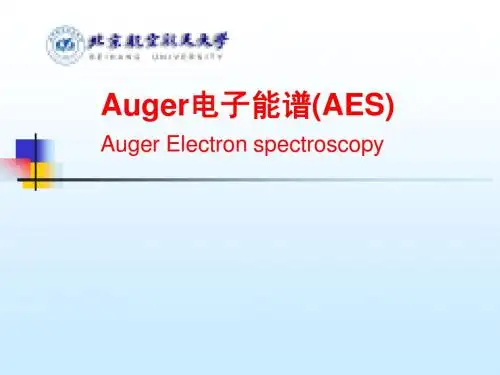
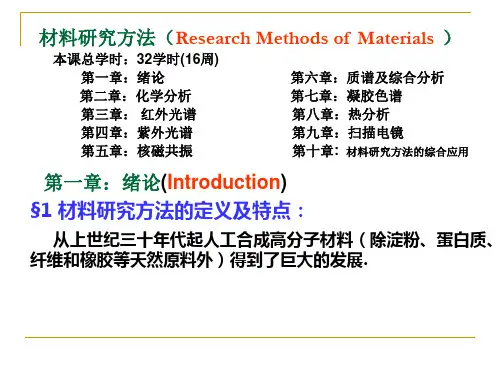
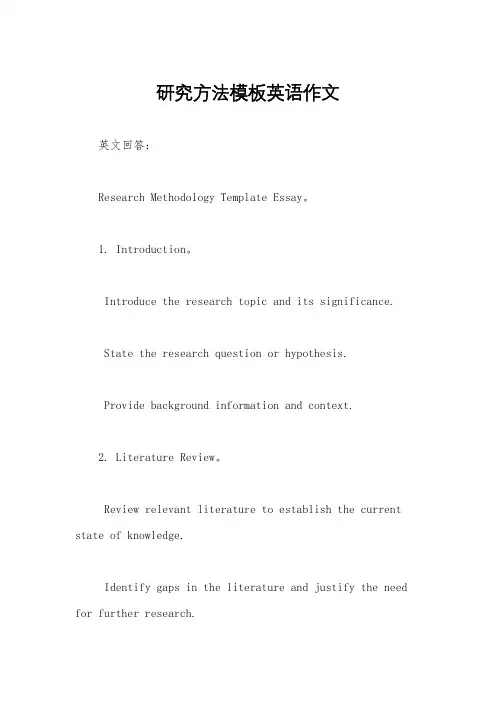
研究方法模板英语作文英文回答:Research Methodology Template Essay。
1. Introduction。
Introduce the research topic and its significance.State the research question or hypothesis.Provide background information and context.2. Literature Review。
Review relevant literature to establish the current state of knowledge.Identify gaps in the literature and justify the need for further research.Summarize key findings and theoretical frameworks.3. Research Methodology。
Research Design: Describe the type of research design used (e.g., qualitative, quantitative, mixed methods).Data Collection: Explain the methods used to collect data (e.g., surveys, interviews, observations).Data Analysis: Outline the analytical techniques used to process and interpret the data.Ethical Considerations: Discuss the ethical considerations involved in the research process.4. Data Presentation and Findings。
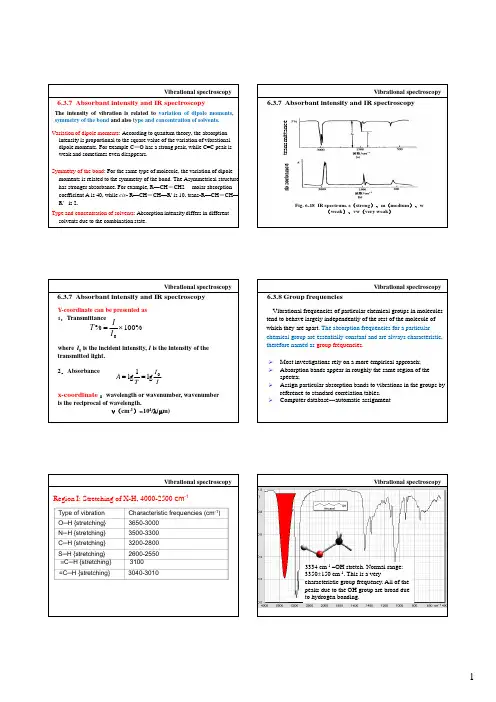
Vibrational spectroscopy6.3.7 Absorbant intensity and IR spectroscopyt r a n s m i t t a n c e Fig. 6-18 IR spectrum. s (strong )、m (medium )、w(weak )、vw (very weak )a b s o r b a n c eVibrational spectroscopy3334 cm -1–OH stretch. Normal range: 3350±150 cm -1. This is a verycharacteristic group frequency. All of the peaks due to the OH group are broad due to hydrogen bonding.Vibrational spectroscopy 3390 cm-1–NH2antisymmetric stretch.Normal range: 3300±100 cm-1. Muchweaker adsorption than the OH stretchin hexanol.Vibrational spectroscopy 3290cm-1–NH2symmetric stretch. 2°amines have only one NH stretch, and3°amines have none.Vibrational spectroscopy Spectral interpretation always starts at the high end, because there are the best group frequencies and they are the easiest to interpret. No peaks appear above 3000 cm-1, the cut-off for unsaturated C-H. the four peaks below 3000 cm-1 are saturated C-H stretching modes.Vibrational spectroscopy 3050 ±50 cm-1 corresponds to the aromatic orunsaturated C(sp2)-H stretch. Always above3000 cm-1. These bands are not assigned tospecific vibrational modes.Vibrational spectroscopy 3080cm-1=CH3080 cm1 2 antisymmetric stretch. An absorption above 3000 cm-1 indicates the presence of an unsaturation (double or triple bond or an aromatic ring).Vibrational spectroscopy 2247 cm-1 C≡N stretch. Normal range:2250±10 cm-1 , lowered 10-20 cm-1when conjugated. Compare to the C ≡Cstretch in 1-heptyne (3000 cm-1).Vibrational spectroscopy 1742 cm-1, -C=O stretch. In small ring esters, this vibration is shifted to higher frequency by coupling to the stretch ofthe adjacent of O-C and C-C bonds. The amount of coupling depends on the O-C(O)-C angle. As with other carbonyl groups, conjugation lowers the frequency.Vibrational spectroscopy 1642 cm-1, C=C stretch. Normalrange:164020cm-1for cis andrange: 1640±20 cm for cis andvinyl, 1670±10 cm-1for trans, tri andtetra substituted. Trans-2-hexene(overlay menu) has only a very weakabsorption, because there is verylittle dipole change when an internaldouble bond stretches (it is nearlysymmetric).Vibrational spectroscopyThe broad peak at approximately 1460 cm-1is actually two overlapping peaks. At1640±10 cm-1, the antisymmetric bend ofthe CH3group absorbs. This is a degenerage bend (one shown).Vibrational spectroscopy At 1375 ±10cm-1, the CH3 symmetric bend (also called the“umbrella” bend) absorbs. This peak is very useful becauseit is isolated from the other peaks. Compare the spectrum ofcyclohexane. The most prominent difference between thetwo spectra is the absence of a CH3 symmetric bend in thecyclohexane spectrum./cm-11715 1800 1828 1928。
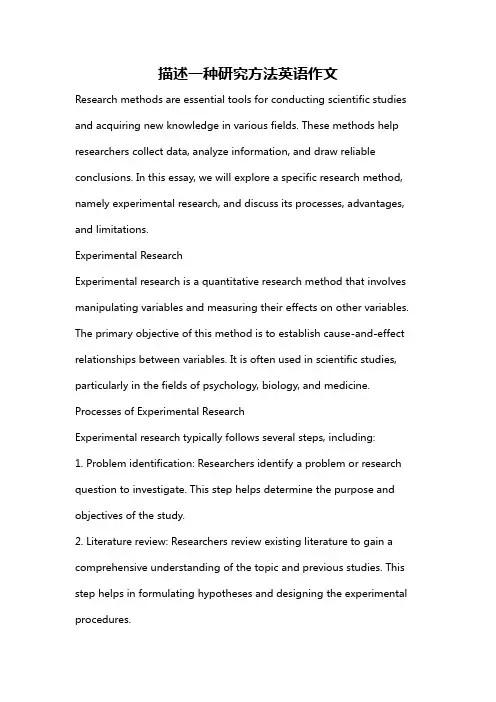
描述一种研究方法英语作文Research methods are essential tools for conducting scientific studies and acquiring new knowledge in various fields. These methods help researchers collect data, analyze information, and draw reliable conclusions. In this essay, we will explore a specific research method, namely experimental research, and discuss its processes, advantages, and limitations.Experimental ResearchExperimental research is a quantitative research method that involves manipulating variables and measuring their effects on other variables. The primary objective of this method is to establish cause-and-effect relationships between variables. It is often used in scientific studies, particularly in the fields of psychology, biology, and medicine. Processes of Experimental ResearchExperimental research typically follows several steps, including:1. Problem identification: Researchers identify a problem or research question to investigate. This step helps determine the purpose and objectives of the study.2. Literature review: Researchers review existing literature to gain a comprehensive understanding of the topic and previous studies. This step helps in formulating hypotheses and designing the experimental procedures.3. Formation of hypotheses: Based on the literature review, researchers formulate hypotheses that predict the relationship between variables. A hypothesis provides a clear direction for the experiment.4. Selection of participants: Researchers select a suitable sample of participants for the study. The sample should be representative of the target population to ensure the generalizability of the findings.5. Design of the experiment: Researchers design the experiment, including selecting the independent and dependent variables, determining the control group, and assigning participants to experimental and control conditions.6. Data collection: Researchers collect data through various methods, such as observation, surveys, interviews, or physiological measurements. The data collected should be valid and reliable.7. Data analysis: Researchers analyze the collected data using statistical techniques to test the hypotheses and determine if there is a significant effect of the manipulated variables.8. Interpretation of results: Based on the data analysis, researchers interpret the results and draw conclusions. They assess whether the experimental manipulation had an impact on the dependent variable and evaluate the significance of the findings.9. Reporting: Researchers write a research report or publish their findings in scientific journals. The report should include the research question,methodology, results, and conclusions.Advantages of Experimental ResearchExperimental research offers several advantages that contribute to its popularity:1. Control over variables: Experimental research allows researchers to control and manipulate variables, ensuring a cause-and-effect relationship can be established.2. Objectivity: The use of systematic procedures and data collection methods in experimental research promotes objectivity and reduces bias.3. Replication: Experimental research can be replicated by other researchers, which helps validate the findings and increase confidence in the results.4. Generalizability: With proper sampling techniques and study design, experimental research findings can be generalized to the target population.Limitations of Experimental ResearchDespite its advantages, experimental research also has limitations:1. Artificial settings: Experimental research often takes place in laboratory settings, which may not reflect real-world contexts accurately. This limitation raises concerns about the external validity of the findings.2. Ethical considerations: In some cases, manipulating variables in experimental research may raise ethical concerns, such as causing harmto participants or violating privacy.3. Time and resources: Conducting experimental research can betime-consuming and resource-intensive due to the need for precise control over variables and data collection.4. Generalizability limitations: The findings of experimental research may not always apply to real-world situations, as participants in laboratory experiments may behave differently from those in natural settings. ConclusionExperimental research is a valuable research method that allows researchers to establish cause-and-effect relationships between variables. It follows a systematic process and provides numerous advantages, such as control over variables and objectivity. However, it also has limitations, including artificial settings and potential ethical concerns. By understanding the processes, advantages, and limitations of experimental research, researchers can effectively utilize this method to advance scientific knowledge and contribute to their respective fields.。

1. In the DSC plot of amorphous FePO4.2H20( Fig.1(a)),the first endothermic peak at about 150°C is related to the dehydration process. Two exothermic peaks were also found at 375 and 440 °C, respectively. These peaks are due to phase transitions, which are discussed below, The DSC plot of crystalline FePO4.2H20 shown in Fig.1(b) is much simpler, indicating the sharp dehydration transition to crystalline FePO4; in this phase the iron is in a distorted tetrahedral environment.在非晶FePO4.2H20(图1(a)),第一个吸热峰约150 °的DSC图C是相关的脱水过程。
也发现了两个放热峰分别在375和440 °C,。
这些峰是由于相变,下面讨论的,在图1(b)所示的结晶FePO4.2H20 DSC情节要简单得多,表明急剧脱水结晶FePO4过渡,在这个阶段,铁在四面体环境。
2.Thermogravimetric (TG) analysis was used to determine the appropriate temperature for heat treatment. The TG curve of the PVA-containing precursor (Fig.1) is typical of a powder mixture consisting of Li2CO3. FeC2O3.2H20. and NH4.H2PO4. for preparing LiFePO4 in good accordance with that reported by Wang qing bin . In addition, it has been previously reported that pyrolysis of PVA in a nitrogen gas flow occurs at 300-425 °C and that only a small amount of residue survives at temperatures up to 450°C. For the PVA-containing precursor,there is an initial loss of lattice water from FeC2O4.2H20 and the NH4H2PO4 decomposes at <250°C. In the temperature range of 250--420°C. there is a weight loss due to decomposition of FeC204 and a reaction with the decomposed product ofNH4H2PO4. while the PVA rapidly decomposes. After the formation of LiFePO4 at 470°C, the product weight decreases slightly. A gradual weight loss is observed above the temperature of LiFePO4 formation in PVA-containing precursor because the pyrolysis of the remaining PVA continues until 600°C. The TG pattern also indicates that the formation of LiFePO4 and the pyrolysis of PVA occur within the same temperature range. This suggests that it is possible to coat carbon simultaneously with the formation of LiFePO4 grains.热重(TG)分析是用来确定适宜的温度下热处理。
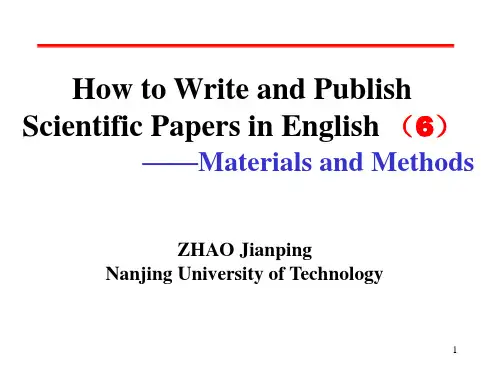
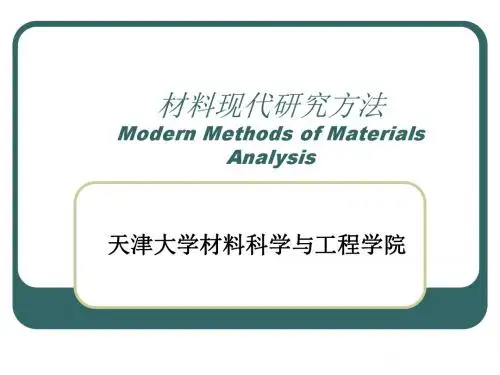
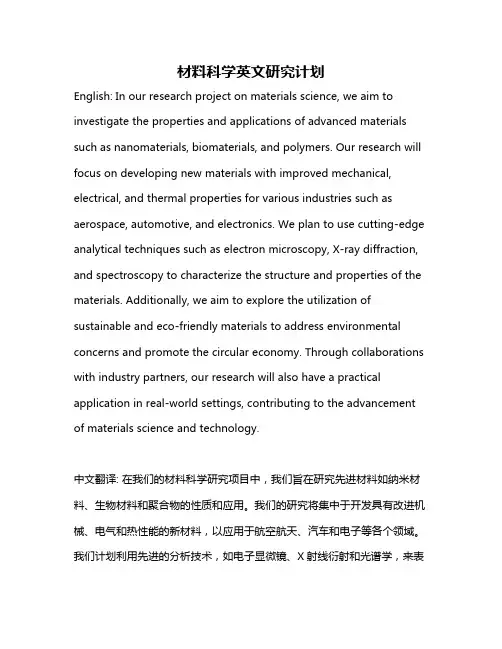
材料科学英文研究计划English: In our research project on materials science, we aim to investigate the properties and applications of advanced materials such as nanomaterials, biomaterials, and polymers. Our research will focus on developing new materials with improved mechanical, electrical, and thermal properties for various industries such as aerospace, automotive, and electronics. We plan to use cutting-edge analytical techniques such as electron microscopy, X-ray diffraction, and spectroscopy to characterize the structure and properties of the materials. Additionally, we aim to explore the utilization of sustainable and eco-friendly materials to address environmental concerns and promote the circular economy. Through collaborations with industry partners, our research will also have a practical application in real-world settings, contributing to the advancement of materials science and technology.中文翻译: 在我们的材料科学研究项目中,我们旨在研究先进材料如纳米材料、生物材料和聚合物的性质和应用。
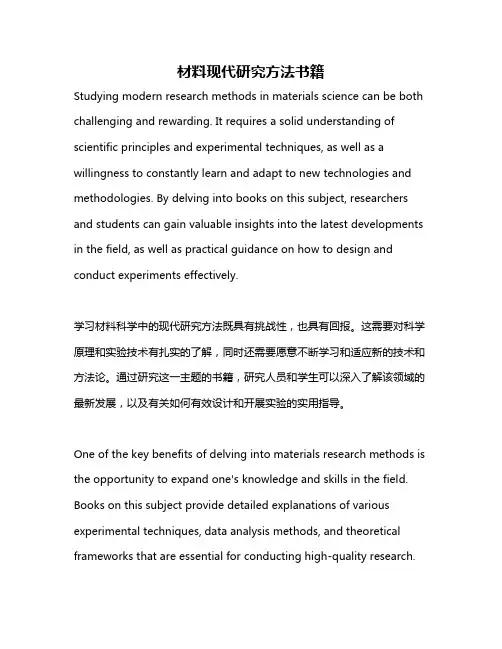
材料现代研究方法书籍Studying modern research methods in materials science can be both challenging and rewarding. It requires a solid understanding of scientific principles and experimental techniques, as well as a willingness to constantly learn and adapt to new technologies and methodologies. By delving into books on this subject, researchers and students can gain valuable insights into the latest developments in the field, as well as practical guidance on how to design and conduct experiments effectively.学习材料科学中的现代研究方法既具有挑战性,也具有回报。
这需要对科学原理和实验技术有扎实的了解,同时还需要愿意不断学习和适应新的技术和方法论。
通过研究这一主题的书籍,研究人员和学生可以深入了解该领域的最新发展,以及有关如何有效设计和开展实验的实用指导。
One of the key benefits of delving into materials research methods is the opportunity to expand one's knowledge and skills in the field. Books on this subject provide detailed explanations of various experimental techniques, data analysis methods, and theoretical frameworks that are essential for conducting high-quality research.By studying these resources, researchers can enhance their problem-solving abilities and develop a deeper understanding of the underlying principles that govern material behavior.深入研究材料研究方法的一个关键好处是扩展自己在这一领域的知识和技能。
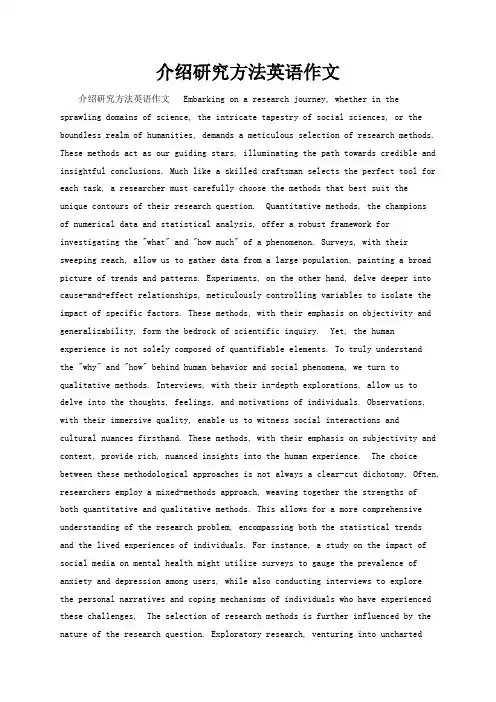
介绍研究方法英语作文介绍研究方法英语作文 Embarking on a research journey, whether in the sprawling domains of science, the intricate tapestry of social sciences, or the boundless realm of humanities, demands a meticulous selection of research methods. These methods act as our guiding stars, illuminating the path towards credible and insightful conclusions. Much like a skilled craftsman selects the perfect tool for each task, a researcher must carefully choose the methods that best suit theunique contours of their research question. Quantitative methods, the championsof numerical data and statistical analysis, offer a robust framework for investigating the "what" and "how much" of a phenomenon. Surveys, with their sweeping reach, allow us to gather data from a large population, painting a broad picture of trends and patterns. Experiments, on the other hand, delve deeper into cause-and-effect relationships, meticulously controlling variables to isolate the impact of specific factors. These methods, with their emphasis on objectivity and generalizability, form the bedrock of scientific inquiry. Yet, the human experience is not solely composed of quantifiable elements. To truly understandthe "why" and "how" behind human behavior and social phenomena, we turn to qualitative methods. Interviews, with their in-depth explorations, allow us to delve into the thoughts, feelings, and motivations of individuals. Observations, with their immersive quality, enable us to witness social interactions andcultural nuances firsthand. These methods, with their emphasis on subjectivity and context, provide rich, nuanced insights into the human experience. The choice between these methodological approaches is not always a clear-cut dichotomy. Often, researchers employ a mixed-methods approach, weaving together the strengths ofboth quantitative and qualitative methods. This allows for a more comprehensive understanding of the research problem, encompassing both the statistical trendsand the lived experiences of individuals. For instance, a study on the impact of social media on mental health might utilize surveys to gauge the prevalence of anxiety and depression among users, while also conducting interviews to explorethe personal narratives and coping mechanisms of individuals who have experienced these challenges. The selection of research methods is further influenced by the nature of the research question. Exploratory research, venturing into unchartedterritory, often relies on qualitative methods to generate hypotheses and identify key variables. Descriptive research, aiming to paint a detailed picture of a phenomenon, might employ surveys and observational studies to gather rich, descriptive data. Explanatory research, seeking to unravel the causal mechanisms underlying a phenomenon, often turns to experiments and quantitative analysis to establish clear cause-and-effect relationships. In conclusion, the choice of research methods is a pivotal decision that shapes the entire research process. By carefully considering the research question, the desired level of depth, and the nature of the data, researchers can select the methods best suited to illuminate the path towards meaningful and impactful conclusions. Whether embracing the rigor of quantitative analysis or delving into the richness of qualitative exploration, the chosen methods act as our compass, guiding us towards a deeper understanding of the world around us.。
Today, I am honored to stand before you as a representative of the Material Science Department to share with you some insights into our field. Material science is a fascinating and rapidly evolving discipline that plays a crucial role in shaping the future of our society.Firstly, let us delve into the definition of material science. Material science is the interdisciplinary field of science, engineering, and technology concerned with the properties, structure, and processing of materials. Materials can be broadly categorized into metals, ceramics, polymers, composites, and biomaterials. Each category has its unique properties and applications, and the field of material science aims to understand and harness these properties for the benefit of humanity.The significance of material science cannot be overstated. Materials are the backbone of modern technology and industry. From the smartphones we use every day to the cars we drive, materials science plays a crucial role in the development and improvement of these products. For instance, the development of lightweight and high-strength materials has revolutionized the automotive industry, leading to more fuel-efficient and safer vehicles. Similarly, advances in materials science have paved the way for renewable energy technologies, such as solar cells and wind turbines, which are essential for addressing climate change and ensuring a sustainable future.In recent years, the field of material science has witnessed remarkable progress, thanks to the advent of new technologies and methodologies. Nanotechnology, for example, has opened up new avenues for material development, allowing us to create materials with unprecedented properties. These novel materials have found applications in various fields, including electronics, medicine, and energy. Another significant development is the emergence of computational materials science, which utilizes computational techniques to predict and design new materials with desired properties. This has significantly reduced the time and cost associated with traditional materials development processes.As a material scientist, it is my responsibility to contribute to the advancement of our field. Here are a few key areas where I believe we can make a significant impact:1. Sustainable materials: The demand for sustainable materials is increasing as we strive to minimize our environmental footprint. We need to develop materials that are renewable, biodegradable, and have a lower carbon footprint. This includes the development of bio-based materials and the optimization of existing materials to reduce their environmental impact.2. Smart materials: Smart materials are responsive to external stimuli, such as temperature, pressure, or electromagnetic fields. Thesematerials have the potential to revolutionize various industries, including healthcare, transportation, and manufacturing. My research focuses on developing smart materials with tailored properties for specific applications.3. Multidisciplinary collaboration: Material science is a highly interdisciplinary field, and collaboration between scientists, engineers, and industry professionals is crucial for achieving breakthroughs. By fostering strong relationships between academia and industry, we can accelerate the development of innovative materials and technologies.In conclusion, material science is a dynamic and ever-evolving fieldthat holds immense potential for improving our lives. As material scientists, we have a unique opportunity to contribute to the development of sustainable, smart, and innovative materials that will shape the future. I urge all of you to embrace the challenges and opportunities presented by our field and strive to make a positiveimpact on the world.Thank you.。
研究素材英文作文初中英文:As a middle school student, I have conducted researchon various materials, including books, articles, and online resources. In my opinion, the most effective way to conduct research is to use a combination of different sources.Firstly, books are a great source of information. They provide in-depth knowledge and are often written by experts in their field. For example, when I was researching the history of ancient China, I found a book written by a renowned historian that provided me with a wealth of information.Secondly, articles are also a valuable source of information. They are often more up-to-date than books and can provide different perspectives on a topic. For instance, when I was researching the impact of social media on teenagers, I found an article written by a psychologistthat provided me with insights into the psychologicaleffects of social media.Lastly, the internet is a vast source of information. However, it is important to be cautious when using online resources, as not all information is accurate or reliable.I always make sure to use reputable websites, such as academic journals and government websites, when conducting research online.中文:作为一名初中生,我进行了各种材料的研究,包括书籍、文章和在线资源。
材料与方法的英语作文Title: "Crafting a Comprehensive Guide to Materials and Methods"Introduction:In the realm of scientific inquiry, the section devoted to Materials and Methods holds paramount importance. It delineates the framework within which experimentation unfolds, ensuring reproducibility and transparency. This essay endeavors to illuminate the essence of constructing a robust Materials and Methods section, pivotal for the advancement of scientific knowledge.1. Clarity and Precision:The cornerstone of an exemplary Materials and Methods section lies in clarity and precision. Every detail pertaining to materials, instruments, and procedures must be elucidated with utmost clarity, leaving no room forambiguity. It is imperative to delineate the source and specifications of materials used, enabling fellow researchers to replicate the experiment accurately.2. Chronological Sequence:A coherent chronological sequence facilitates comprehension and replication of the experimental procedure. Begin with a concise overview of the experimental design, followed by a meticulous account of materials utilized. Subsequently, delineate the experimental procedures in a step-by-step manner, ensuring logical progression. Incorporating figures or flowcharts can further enhance clarity, providing a visual aid for understanding the experimental workflow.3. Validation and Reproducibility:Validation of experimental protocols is indispensableto ascertain the reliability and reproducibility of results. Prior to embarking on experimentation, validate methodologies through pilot studies or control experiments.Additionally, emphasize parameters such as temperature, pH, and humidity, which exert a profound influence on experimental outcomes. By meticulously documenting validation procedures, researchers bolster the credibility of their findings and foster trust within the scientific community.4. Ethical Considerations:Ethical integrity must permeate every facet ofscientific inquiry, extending to the Materials and Methods section. Explicitly articulate adherence to ethical guidelines and institutional protocols governing research involving human subjects, animals, or sensitive materials. Prioritize the welfare of subjects involved in experimentation and obtain requisite ethical approvals to avert potential ethical breaches.5. Statistical Analysis:Incorporating robust statistical analyses enhances the rigor and validity of research findings. Clearly delineatestatistical methods employed for data analysis, including measures of central tendency, dispersion, and inferential statistics. Provide sufficient information to enable readers to scrutinize the statistical rigor employed and assess the reliability of conclusions drawn from the data.6. Anticipating Limitations:Transparently acknowledge inherent limitations and constraints encountered during experimentation. Address potential sources of bias, confounding variables, or unforeseen challenges that may impinge upon the interpretation of results. By candidly acknowledging limitations, researchers demonstrate intellectual honesty and pave the way for future investigations aimed at circumventing these constraints.Conclusion:In summation, the Materials and Methods section serves as the scaffolding upon which scientific inquiry rests, delineating the blueprint for experimentation. By adheringto principles of clarity, precision, validation, and ethical integrity, researchers fortify the foundations of their research endeavors. A meticulously crafted Materials and Methods section not only facilitates reproducibility but also engenders confidence in the veracity andreliability of scientific findings, thereby propelling the frontiers of knowledge ever forward.。
Vibrational spectroscopy6.3.1 Fundamentals of vibrational spectroscopyDefinition Vibrational spectroscopy:is concerned with the d t ti f t iti detection of transitions between energy levels in molecules that result from stretching and bending vibrations of the interatomic bonds.asymmetricalVibrational spectroscopyKinds of vibrational spectroscopy ¾Infra-red spectroscopy(more sensitive to polarized group)6.3.1 Fundamentals of vibrational spectroscopysymmetrical¾Raman spectroscopy (moresensitive to non-polarized)Both methods are concerned with vibrations in molecules , they differ in the manner in which interaction with the exciting radiation occurs .Linear PE: (a) IR, (b)RamanFig. 6-14 Dipole moment of HClVibrational spectroscopyVibrating of Disulfide carbonSymmetrical stretchingInfrared inactive 6.3.2 Infrared spectroscopyAsymmetrical stretchingBendingInfrared activeInfrared inactive Fig. 6-15 Vibration of Disulfide carbonm1lowHigh/cm-1High/cm-1lowVibrational spectroscopy Methylbenzene(甲苯)2005.2 S. Guv =0 represents the ground state v =l the excited vibrational state6.3.3 Raman spectroscopy(1)(2)(3)Vibrational spectroscopy ¾The essential prerequisite for Raman scattering is a change in the polarizability of the bond when vibrations occur.Polarizability may be thought of as a measure of 6.3.3 Raman spectroscopy¾Polarizability may be thought of as a measure of theFig. 6-16 Motion state of linear molecules Degrees of freedom (H2O) : 3×3−6 = 3Vibraitonal modes (methylene group):2926cm-1(s)asνAsymmetricalsν: 2853 cm Symmetricalδ:1468 cm-1(m) δr:720 cm-1(CH1306~1303cm-1(w)γt :1250cmscissoring rocking waggingHexaneFour peakspSpectral interpretation always starts at the high end, because there are the best group frequencies and they are the easiest to interpret. No peaks appear above 3000 cm-1, the cut-off for unsaturated C-H. the four peaks below 3000 cm-1 are saturated C-H stretching modes.HexaneThe peak at 2962 cm-1 isassigned to the antisymmetricassigned to the antisymmetricstretch of the CH3group. Thisvibration is always found inthe range 2962±10 cm-1. thereare actually two degenerateantisymmetric stretchingmodes (only one shown).HexaneAt 2926cm-1, the CH2antisymmetric stretchabsorbs.Normal range:2926±10 cm-1.HexaneAt 2872cm-1, the CH3symmetric stretchabsorbs.Normal range:2872±10 cm-1.HexaneAt2853-1,the CHAt 2853cm, the CH2symmetric stretchabsorbs.Normal range:2853±10 cm-1.Vibrational spectroscopy Hexane1470cm-1This is the C-H bendingregion, expanded to show thenearly overlapping peaks forthe CH3and CH2bends.Vibrational spectroscopyHexanerocking When four or more CH2groups arein a chain, a vibration at 720±10cm-1corresponds to concertedrocking of all of the CH2’s.Vibrational spectroscopyHexanol3334 cm-1–OH stretch. Normal range: 3350±150 cm-1.This is a very characteristic group frequency. All of thepeaks due to the OH group are broad due to hydrogenbonding.Vibrational spectroscopy Hexanol 1430 cm -1–OH bend . Normal range: 1400±100 cm -1. This broad peak is buried under the CH bending modes.Vibrational spectroscopyHexanol660 cm -1–OH wag. While not a group frequency, this is another band due to the OH.Vibrational spectroscopy Aromatic ring expansion (Methylbenzene )At 1601 cm -1, thesymmetric ring strethch absorbs. Normal range: 1590±10 cm -1. This ib ti h di lOnly notsymmetrically substituted.vibration has a dipole change (and absords in IR) only when notsymmetrically substituted. The intensity of this band also varies with thesubstituent. Compare to p-xylene from the overlay menu.Vibrational spectroscopyAromatic ring expansion (Methylbenzene )At 1500cm -1, a different ring stretch absorbs. Range: 1500±10cm -1. Variable intensityVibrational spectroscopy 6.3.6 Comparing of IR and Raman SpectroscopyasymmetricalsymmetricalFig. 6-17 Linear PE: (a) IR, (b) Raman。
建筑材料调研报告英语Building Materials Research Report1. IntroductionBuilding materials play a significant role in the construction industry. They are essential for the construction of various structures, including residential and commercial buildings, bridges, and roads. The purpose of this report is to provide an overview of different types of building materials and their characteristics.2. CementCement is a crucial building material used for the construction of foundations and structures. It is a fine powder, commonly composed of limestone and clay, which hardens when mixed with water. Cement provides strength and durability to the structures and is widely used in the construction industry.3. ConcreteConcrete is a composite material made up of cement, aggregates (such as sand and gravel), and water. It is versatile and extensively used in construction due to its durability, strength, and fire resistance. Concrete can be molded into various shapes and is a key material in the construction of foundations, walls, and floors.4. SteelSteel is a widely used building material due to its high strength and versatility. It is commonly used in the construction of beams, columns, and frameworks of buildings. Steel structures are durable and can withstand extreme weather conditions. Moreover, steel is recyclable and environmentally friendly.5. BrickBrick is a traditional building material made from clay. It is known for its strength, durability, and fire resistance. Bricks are commonly used in the construction of walls and paving. They can be manufactured in different shapes, sizes, and colors to suit specific architectural designs.6. WoodWood has been used as a building material for centuries. It is renewable, lightweight, and easy to work with. Wood is commonly used in the construction of frames, floors, and roofs. It provides insulation and has aesthetic appeal. However, wood is susceptible to fire, decay, and insect damage, requiring proper maintenance and treatment.7. GlassGlass is a versatile building material that offers transparency and natural light to the structures. It is used in windows, doors, and facades. Depending on its composition, glass can provide thermal insulation, sound insulation, and safety properties. Glass is also recyclable and contributes to energy efficiency in buildings.8. Sustainability and Green Building MaterialsSustainability and environmental consciousness are becoming increasingly important in the construction industry. Green building materials, such as recycled concrete, bamboo, and sustainable timber, are gaining popularity due to their low environmental impact. These materials minimize energy consumption, reduce waste, and improve indoor air quality.9. ConclusionBuilding materials have a significant impact on the design, function, and longevity of structures. The choice of materials should consider factors such as durability, strength, sustainability, and cost-effectiveness. The construction industry is continuously exploring innovative materials and technologies to enhance the performance and sustainability of buildings.。
英文研究方法模板作文英文:Research methods are essential for any academic study. They help us to gather data, analyze it, and draw conclusions. There are several research methods that onecan use, including qualitative and quantitative methods. Qualitative research involves collecting non-numerical data, such as interviews, observations, and case studies. Quantitative research, on the other hand, involvescollecting numerical data, such as surveys and experiments.To conduct research, one needs to follow a few steps. The first step is to define the research question or problem. This involves identifying the topic of interestand the specific questions that need to be answered. The next step is to design the study, which includes selecting the appropriate research method and deciding on the sample size and data collection methods. The third step is to collect the data, which involves gathering information fromthe selected sample using the chosen data collection methods. The fourth step is to analyze the data, which involves organizing and interpreting the data to draw conclusions. The final step is to report the findings, which involves presenting the results in a clear and concise manner.One important aspect of research methods is validity and reliability. Validity refers to the accuracy of the research findings, while reliability refers to the consistency of the research findings. To ensure validity and reliability, researchers need to use appropriate research methods and collect data from a representative sample.In conclusion, research methods are crucial for any academic study. They help us to gather data, analyze it, and draw conclusions. By following the steps of research, we can ensure that our findings are valid and reliable.中文:研究方法对于任何学术研究都是至关重要的。